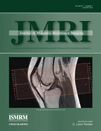3D coronary motion tracking in swine models with MR tracking catheters
Abstract
Purpose
To develop MR-tracked catheters to delineate the three-dimensional motion of coronary arteries at high spatial and temporal resolution.
Materials and Methods
Catheters with three tracking microcoils were placed into nine swine. During breath-holds, electrocardiographic (ECG)-synchronized 3D motion was measured at varying vessel depths. 3D motion was measured in American Heart Association left anterior descending (LAD) segments 6–7, left circumflex (LCX) segments 11–15, and right coronary artery (RCA) segments 2–3, at 60–115 beats/min heart rates. Similar-length cardiac cycles were averaged. Intercoil cross-correlation identified early systolic phase (ES) and determined segment motion delay.
Results
Translational and rotational motion, as a function of cardiac phase, is shown, with directionality and amplitude varying along the vessel length. Rotation (peak-to-peak solid-angle RCA ≈0.10, LAD ≈0.06, LCX ≈0.18 radian) occurs primarily during fast translational motion and increases distally. LCX displacement increases with heart rate by 18%. Phantom simulations of motion effects on high-resolution images, using RCA results, show artifacts due to translation and rotation.
Conclusion
Magnetic resonance imaging (MRI) tracking catheters quantify motion at 20 fps and 1 mm3 resolution at multiple vessel depths, exceeding that available with other techniques. Imaging artifacts due to rotation are demonstrated. Motion-tracking catheters may provide physiological information during interventions and improve imaging spatial resolution. J. Magn. Reson. Imaging 2009;29:86–98. © 2008 Wiley-Liss, Inc.




